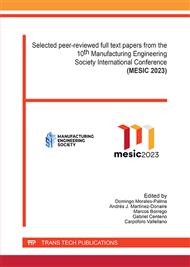[1]
Davim, J. Paulo, ed. Surface integrity in machining. Vol. 1848828742. London: Springer, 2010.
Google Scholar
[2]
Arrazola, Pedro J., et al. "Broaching: Cutting tools and machine tools for manufacturing high quality features in components." CIRP Annals 69.2 (2020): 554-577.
DOI: 10.1016/j.cirp.2020.05.010
Google Scholar
[3]
Ozturk, Ozkan, and Erhan Budak. "Modeling of broaching process for improved tool design." ASME International Mechanical Engineering Congress and Exposition. Vol. 37203. 2003.
DOI: 10.1115/imece2003-42304
Google Scholar
[4]
Hosseini, A., and H. A. Kishawy. "Prediction of cutting forces in broaching operation." Journal of Advanced Manufacturing Systems 12.01 (2013): 1-14.
DOI: 10.1142/s0219686713500017
Google Scholar
[5]
Kishawy, Hossam A., et al. "An energy based analysis of broaching operation: Cutting forces and resultant surface integrity." CIRP annals 61.1 (2012): 107-110.
DOI: 10.1016/j.cirp.2012.03.004
Google Scholar
[6]
Del Olmo, A., et al. "Tool wear monitoring of high-speed broaching process with carbide tools to reduce production errors." Mechanical Systems and Signal Processing 172 (2022): 109003.
DOI: 10.1016/j.ymssp.2022.109003
Google Scholar
[7]
Loizou, Jamie, et al. "Automated wear characterization for broaching tools based on machine vision systems." Journal of Manufacturing Systems 37 (2015): 558-563.
DOI: 10.1016/j.jmsy.2015.04.005
Google Scholar
[8]
Axinte, Dragoş A. "Approach into the use of probabilistic neural networks for automated classification of tool malfunctions in broaching." International Journal of Machine Tools and Manufacture 46.12-13 (2006): 1445-1448.
DOI: 10.1016/j.ijmachtools.2005.09.017
Google Scholar
[9]
Hosseini, A. "On the quality and integrity of broached surfaces." The International Journal of Advanced Manufacturing Technology 102.1 (2019): 95-103.
Google Scholar
[10]
Legutko, S., P. Kluk, and A. Stoić. "Research of the surface roughness created during pull broaching process." Metalurgija-Zagreb 50.4 (2011): 245.
Google Scholar
[11]
Fabre, D., et al. "Optimization of surface roughness in broaching." CIRP Journal of Manufacturing Science and Technology 18 (2017): 115-127.[12] Kong, Xiangwei, et al. "Broaching performance of superalloy GH4169 based on FEM." Journal of Materials Science & Technology 27.12 (2011): 1178-1184.
DOI: 10.1016/s1005-0302(12)60015-2
Google Scholar
[13]
Seimann, Martin, et al. "Model-based analysis in finish broaching of inconel 718." The International Journal of Advanced Manufacturing Technology 97.9 (2018): 3751-3760.
DOI: 10.1007/s00170-018-2221-5
Google Scholar
[14]
Ortiz-de-Zarate, Gorka, et al. "Surface topography irregularities generated by broaching." CIRP Annals (2022).
DOI: 10.1016/j.cirp.2022.03.028
Google Scholar
[15]
Altintas, Yusuf, and A. A. Ber. "Manufacturing automation: metal cutting mechanics, machine tool vibrations, and CNC design." Appl. Mech. Rev. 54.5 (2001): B84-B84.
DOI: 10.1115/1.1399383
Google Scholar
[16]
International Organization for Standardization. "Geometrical product specifications (GPS) - Filtration - Part 21: Linear profile filters: Gaussian filters" ISO 16610-21:2011. (2011)
DOI: 10.3403/30429462u
Google Scholar
[17]
International Organization for Standardization. "Geometrical Product Specifications (GPS)-surface Texture: Profile Method-rules and Procedures for the Assessment of Surface Texture" ISO 4287:1997. (1997)
DOI: 10.3403/02337030
Google Scholar



